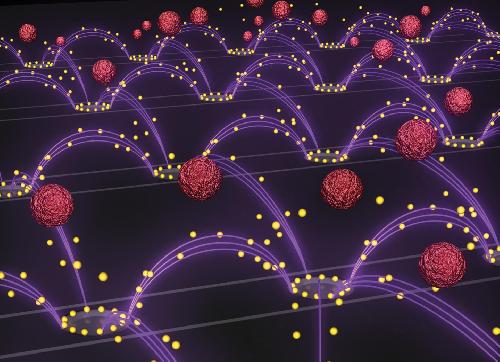Engineers have developed a new technology that uses an oscillating electric field to easily and quickly isolate drug-delivery nanoparticles from blood.
Nanoparticles are generally one thousand times smaller than the width of a human hair and are difficult to separate from plasma, the liquid component of blood, due to their small size and low density. Traditional methods to remove nanoparticles from plasma samples typically involve diluting the plasma, adding a high concentration sugar solution to the plasma and spinning it in a centrifuge, or attaching a targeting agent to the surface of the nanoparticles.
These methods either alter the normal behavior of the nanoparticles or cannot be applied to some of the most common nanoparticle types.

This new nanoparticle separation technology will enable researchers -- particularly those who design and study drug-delivery nanoparticles for disease therapies -- to better monitor what happens to nanoparticles circulating in a patient's bloodstream. One of the questions that researchers face is how blood proteins bind to the surfaces of drug-delivery nanoparticles and make them less effective.
The device used to isolate the drug-delivery nanoparticles was a dime-sized electric chip manufactured by La Jolla-based Biological Dynamics, which licensed the original technology from UC San Diego. The chip contains hundreds of tiny electrodes that generate a rapidly oscillating electric field that selectively pulls the nanoparticles out of a plasma sample. Researchers inserted a drop of plasma spiked with nanoparticles into the electric chip and demonstrated nanoparticle recovery within 7 minutes. The technology worked on different types of drug-delivery nanoparticles that are typically studied in various labs.
The breakthrough in the technology relies on designing a chip that can work in the high salt concentration of blood plasma. The chip's ability to pull the nanoparticles out of plasma is based on differences in the material properties between the nanoparticles and plasma components. When the chip's electrodes apply an oscillating electric field, the positive and negative charges inside the nanoparticles reorient themselves at a different speed than the charges in the surrounding plasma. This momentary imbalance in the charges creates an attractive force between the nanoparticles and the electrodes. As the electric field oscillates, the nanoparticles are continually pulled towards the electrodes, leaving the rest of the plasma behind. Also, the electric field is designed to oscillate at just the right frequency: 15,000 times per second.




Comments